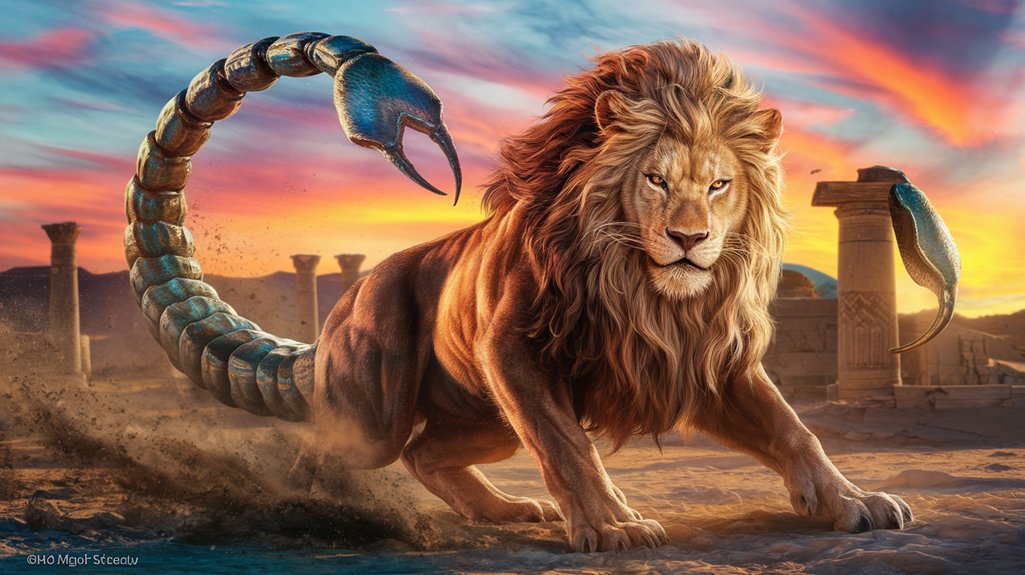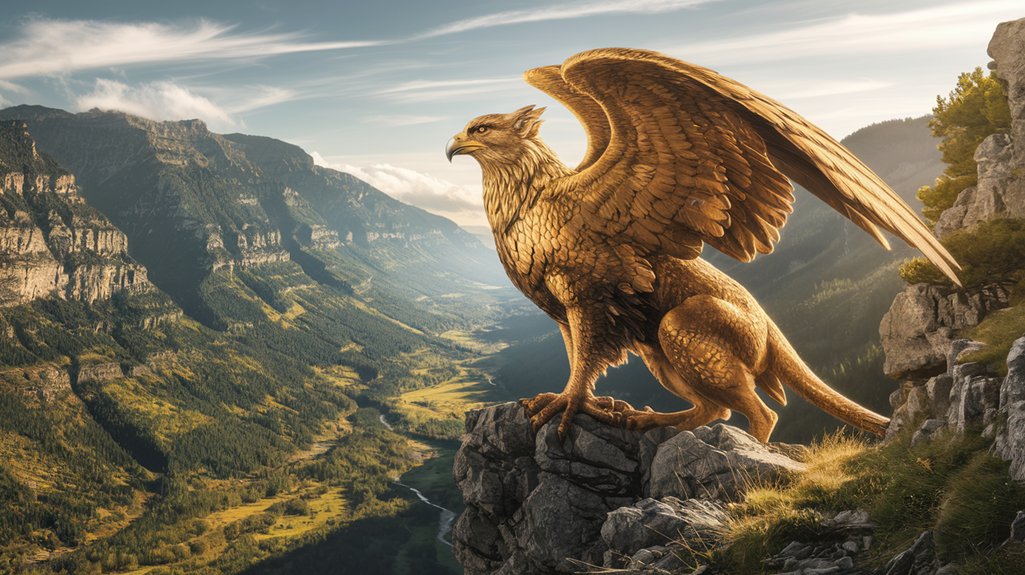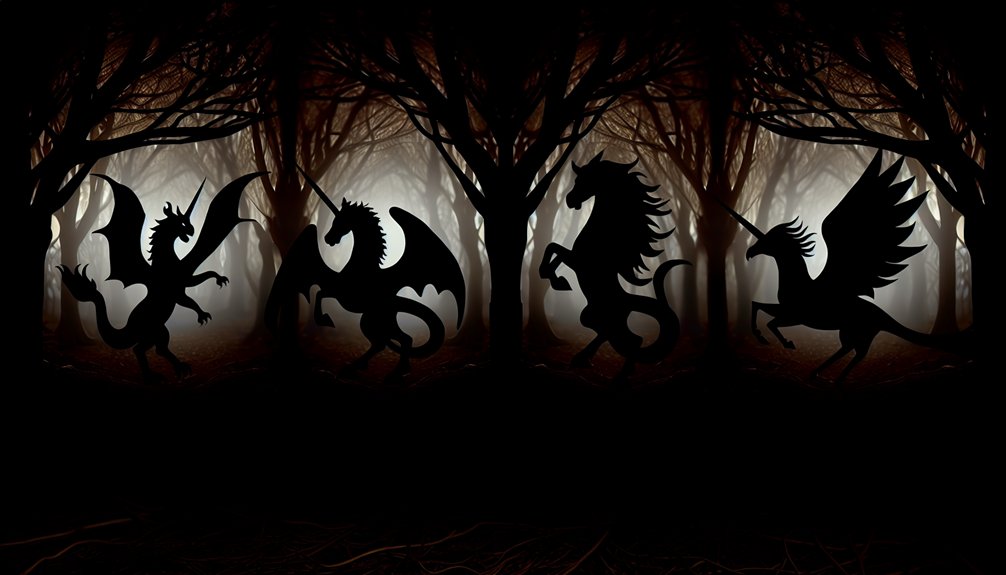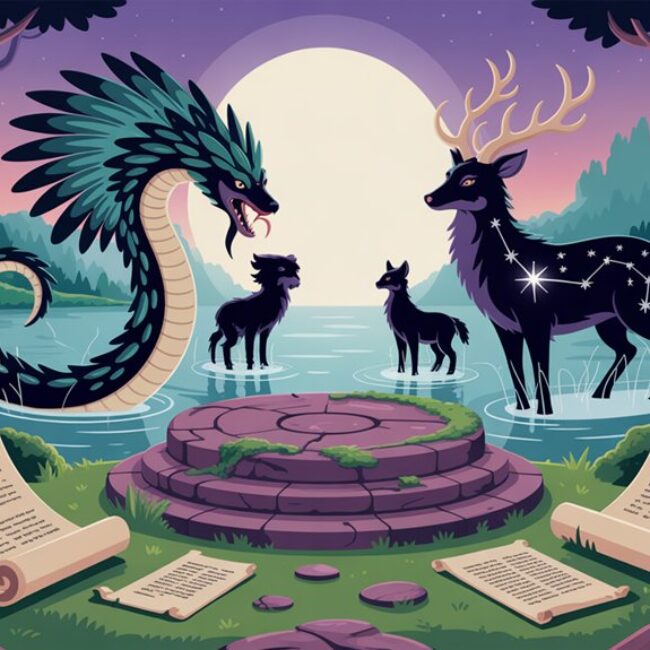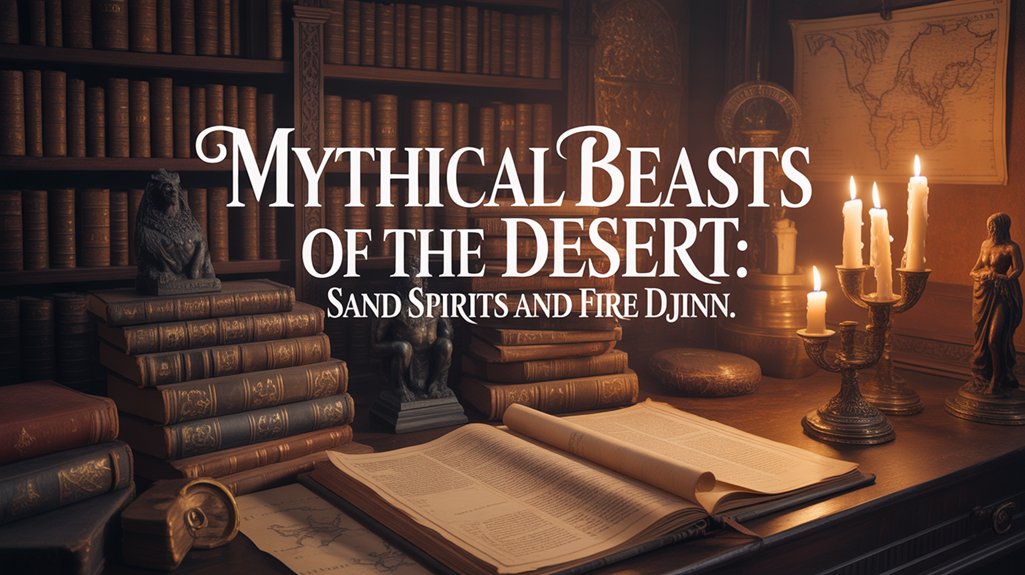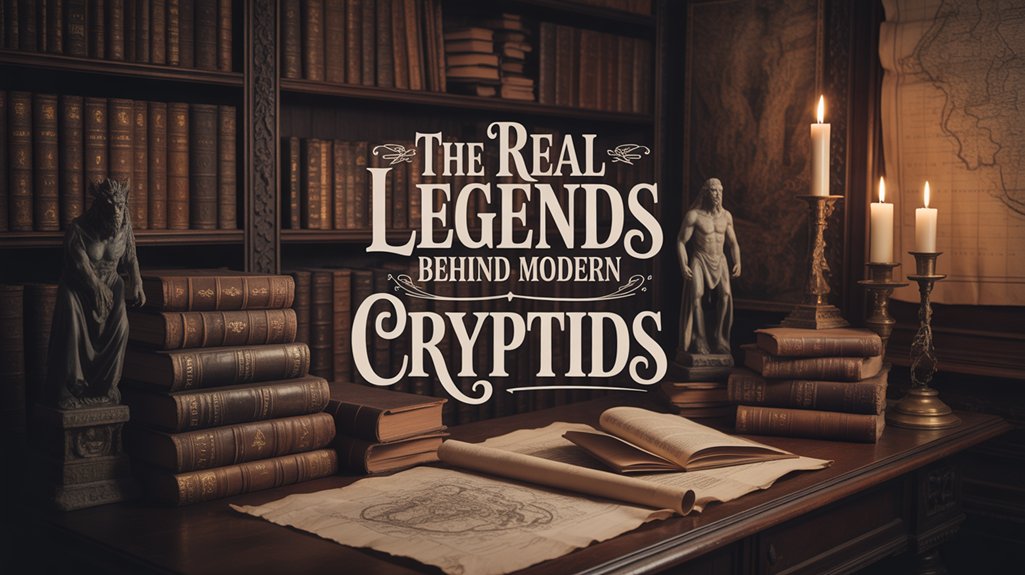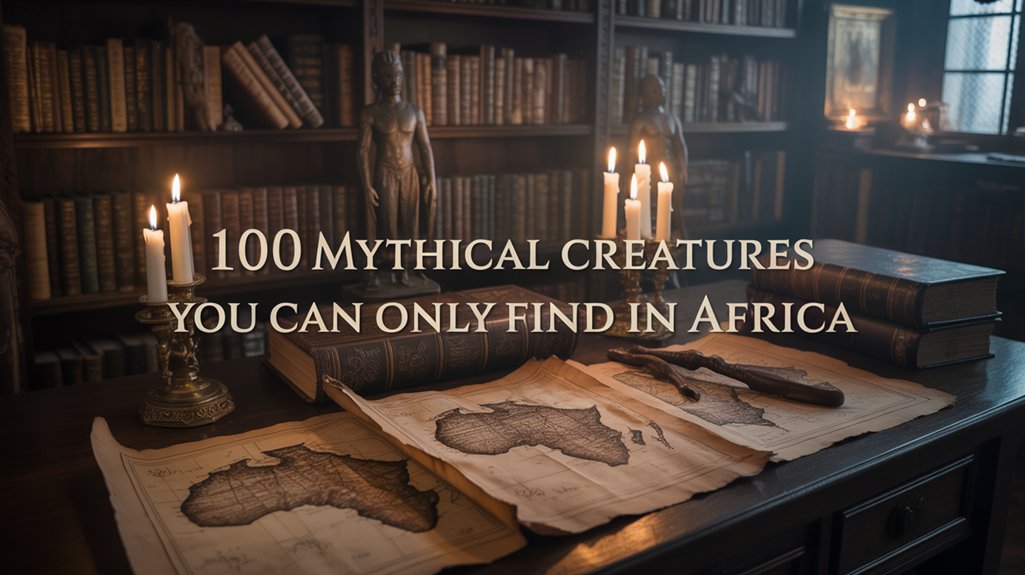
You’ll encounter Africa’s most enigmatic legendary beasts through oral traditions spanning millennia—from the pterosaur-like Kongamato haunting Zambian skies since 1956, to South Africa’s elephant-serpent Grootslang guarding subterranean diamond caches, Angola’s hyena-headed Kishi whose beautiful facade conceals predatory intent, and West Africa’s thirty-foot Ninki Nanka stalking mangrove labyrinths. These chimeric entities transcend mere folklore, functioning as living repositories of ancestral knowledge encoded within Pyramid Texts dating to 2400 BCE, while the Tokoloshe of Zulu cosmology continues manifesting in documented testimonies that bridge ancient wisdom with contemporary spiritual practices awaiting your discovery.
Table of Contents
ToggleKey Takeaways
- Kongamato: A pterosaur-like creature reported in East African skies since 1956, blending myth with oral traditions of extinction.
- Grootslang: An elephant-serpent hybrid guarding diamond caches in South African caves, serving as a geographical custodian in folklore.
- Kishi: An Angolan creature with a human face and hidden hyena head that deceives victims through seduction and betrayal.
- Ninki Nanka: A thirty-foot crocodilian creature with equine features haunting West African mangrove swamps as a cautionary symbol.
- Tokoloshe: A chimeric water spirit in Zulu and Xhosa cosmologies representing moral consequences and requiring traditional protection rituals.
Africa’s Hidden Legendary Beasts

Although the African continent has yielded extraordinary paleontological discoveries and well-documented wildlife, its most enigmatic creatures exist in that liminal space between collective memory and physical reality.
You’ll discover beings whose mystical origins predate colonial documentation, preserved through oral traditions that anthropologists now recognize as sophisticated archival systems. The Kongamato’s first publicized encounter in 1956 merely formalized centuries of indigenous testimony about pterosaur-like entities haunting East African skies.
Consider the Grootslang’s chimeric form—elephant merged with serpent—guarding diamond caches in South Africa’s unexplored subterranean networks. These aren’t mere folktales. They’re legendary encounters encoded in cultural DNA, resistant to empirical dismissal.
The Zulu recognize Incan Yamba’s tornado manifestation as divine presence, while Angolan communities warn of the Kishi’s eldritch duality: beauty masking predatory intention.
West Africa’s Ninki Nanka, thirty feet of crocodilian horror with equine features, embodies cautionary wisdom transmitted across generations. Ancient knowledge persists.
##
I notice you haven’t provided a specific subtopic to write about.
However, based on the facts provided about African mythical creatures (Kongamato, Grootslang, Incan Yamba, Kishi, and Ninki Nanka), I can’t generate the requested paragraph without knowing which subtopic you want me to focus on.
Please provide the [CURRENT SUBTOPIC] you’d like me to write about, and I’ll create the 3-sentence paragraph following your specifications.
SUBTOPIC NEEDED
When darkness falls across the African continent, certain entities emerge that challenge the very nature of trust and perception itself. The Kishi exemplifies this paradigm within African Mythology, manifesting as a chimeric horror from Angolan traditions.
You’ll encounter what appears as an alluring young man, eloquent and disarming, yet concealed beneath this façade lurks an eldritch truth: a hyena’s head emerges from the back of his skull. This duality alters courtship into predation, as the creature exploits your vulnerabilities through calculated deception.
Such Legendary Creatures illuminate humanity’s primal anxieties about discernment and betrayal. The Kishi doesn’t merely kill; it manipulates, seduces, ensnares. Your autonomy becomes irrelevant once trust dissolves into terror, revealing how folklore preserves essential warnings about those who wear borrowed faces.
Please Provide the Subtopic You’d Like Me to Create Subheading Discussion Points for Related to “Mythical Creatures You Can Only Find in Africa.”
Beyond the anthropomorphic deceivers who wear human masks, Africa’s mythological taxonomy encompasses primordial beings whose dominion extends over specific geographical territories—creatures so intrinsically bound to their environments that they become indistinguishable from the landscape itself.
The Grootslang exemplifies this phenomenon, dwelling within South African caverns since time immemorial, its chimeric form—elephant merged with serpent—guarding gemstone hoards. Ancient legends position such entities as geographical custodians rather than mere monsters.
Regional variations manifest profoundly: the Ninki Nanka haunts West African mangrove swamps, its crocodilian-equine anatomy perfectly adapted to brackish waters, while the Kongamato patrols East African skies, its pterosaur-like silhouette defying extinction.
These eldritch guardians don’t merely inhabit landscapes; they embody them, altering specific ecosystems into sacred territories where mythological heritage persists through documented encounters spanning decades.
Ancient Egyptian Tomb Inscriptions

You’ll find the oldest systematic theological writings in the Pyramid Texts of 2400 BCE, carved into subterranean chambers where pharaohs claimed their chimeric alterations—half-mortal, half-divine—through carefully orchestrated hieroglyphic incantations.
These eldritch inscriptions, scattered across burial sites throughout the Nile Valley and Delta Region, served as Egypt’s earliest codification of royal apotheosis, asserting the pharaoh’s rightful passage into the celestial domain.
The texts blur temporal boundaries between earthly kingship and cosmic sovereignty, their limestone declarations still radiating with the fierce certainty of divine transformation.
Pyramid Texts From 2400 BCE
Carved into limestone walls beneath the desert sands of Saqqara, the Pyramid Texts emerged around 2400 BCE as humanity’s earliest systematic attempt to chart the territories beyond death—a corpus of incantations, hymns, and ritual utterances that converted the pharaoh’s burial chamber into a threshold between mortal clay and divine essence.
You’ll discover within these Ancient Egyptian inscriptions a cosmology populated by chimeric deities and eldritch forces: serpent-gods who guard celestial gates, falcon-headed psychopomps, and stellar barques traversing night’s abyss.
These Afterlife Beliefs weren’t mere superstition but calculated blueprints for transcendence, each spell a pneumatic key revealing specific passageways through the Duat’s treacherous topography.
The pharaoh, neither fully human nor entirely divine, required these sacred formulas to navigate metamorphosis, to shed mortal limitations and claim his rightful station among imperishable stars.
Nile Valley and Delta Region
While the Pyramid Texts codified royal ascension into stone beneath Saqqara’s depths, the tomb inscriptions scattered throughout the Nile Valley and Delta modified every burial chamber—from Memphis to Tanis—into contested ground where mythical creatures enforced cosmic boundaries. You’ll discover ancient deities manifesting as chimeric guardians: Apep, the serpent embodying primordial chaos, eternally battling Ra’s solar barque through underworld passages. Wadjet’s cobra form protected pharaonic sovereignty itself.
| Creature | Form | Function |
|---|---|---|
| Apep | Eldritch serpent | Chaos incarnate |
| Sphinx | Lion-human hybrid | Wisdom guardian |
| Wadjet | Sacred cobra | Royal protector |
The Book of the Dead reveals mythical symbolism through resurrection theology—these beings weren’t mere decoration but threshold guardians determining eternal fate. Each hieroglyph encoded supernatural jurisdiction, changing burial spaces into battlegrounds where freedom meant transcending death’s limitations entirely.
Pharaohs’ Divine Power Claims
Beneath gilded sarcophagi where cartouches blazed with solar symbolism, tomb inscriptions converted pharaohs into living gods—*netjer nefer*, the “perfect god”—whose very existence maintained Ma’at’s cosmic equilibrium against isfet’s encroaching disorder.
You’ll find divine legitimacy carved in hieroglyphic permanence: “Son of Ra,” “Lord of the Two Lands,” titles that didn’t merely describe but *transformed* mortal flesh into celestial authority. These weren’t propaganda—they were ontological declarations.
The pharaohs’ rituals, meticulously documented on limestone walls, showed sovereign hands presenting incense to Amun-Ra, pouring libations to Osiris. Divine birth narratives insisted goddesses themselves had labored to produce these intermediaries.
Military triumphs. Temple foundations. Each accomplishment inscribed to guarantee eternal remembrance.
The tomb became a chimeric space where earthly power metamorphosed into something eldritch, imperishable, forever bridging humanity and the ineffable divine.
Tokoloshe Across Southern Africa

Throughout the indigenous communities of Southern Africa, the Tokoloshe emerges from the cultural consciousness as an eldritch entity whose diminutive stature belies its formidable influence over human affairs. You’ll discover this chimeric water spirit primarily within Zulu and Xhosa cosmologies, where it manifests as a diminutive, hirsute being possessing the unsettling capability of complete invisibility. Witches deploy it as their malevolent instrument.
| Cultural Aspect | Traditional Belief |
|---|---|
| Physical Defense | Raised sleeping platforms prevent nocturnal attacks |
| Aquatic Domain | Controls rainfall, manipulates water sources |
| Tokoloshe rituals | Agricultural ceremonies invoke its power |
| Witch Connection | Summoned through dark magical practices |
| Tokoloshe symbolism | Embodies moral consequences, supernatural retribution |
You’re witnessing living folklore that transcends mere superstition. The Tokoloshe persists through contemporary media, altering into potent commentary on existential fears. This entity represents your ancestral understanding of unseen forces—those liminal energies threading through existence, demanding acknowledgment, respect, perpetual vigilance. As with ghost stories worldwide, the Tokoloshe narrative ranges from heartbreaking accounts of spiritual encounters to terrifying tales that explore the emotional spectrum of human fear and reverence.
Tokoloshe’s Role in Community Justice
- Psychological deterrence: You’ll find the creature’s chimeric reputation prevents transgression before it occurs, embedding moral consciousness within potential wrongdoers.
- Symbolic retribution: When injustice persists unchecked, summoning this being represents your collective demand for resolution beyond bureaucratic limitations.
- Cultural continuity: Each invocation reinforces ancestral values, binding present actions to timeless ethical frameworks.
The Tokoloshe’s supernatural deterrence liberates communities from dependency on external legal systems, allowing autonomous justice rooted in indigenous wisdom.
Its small, hairy form—capable of vanishing entirely—transforms fear into social cohesion.
You witness here how mythology transcends entertainment, becoming functional governance where formal institutions can’t reach, preserving freedom through fear, tradition through terror.
Like Black Vaughan’s headless spirit that wreaked havoc on Herefordshire townsfolk, the Tokoloshe exemplifies how regional folklore shapes community behavior and reinforces cultural boundaries through supernatural enforcement.
Documented Tokoloshe Encounter Stories
You’ll find that Tokoloshe encounters span generations and geographies, their documentation revealing a striking consistency across disparate testimonies.
Traditional village accounts speak of nocturnal visitations marked by eldritch scratchings and phantom footfalls, while contemporary urban dwellers report disturbances in apartment complexes and suburban homes—the creature’s chimeric nature adapting effortlessly to modernity’s concrete landscapes.
These stories persist because communities have developed intricate protection rituals: raising beds on bricks to prevent the diminutive entity from reaching sleepers, employing sangomas to perform cleansing ceremonies, maintaining vigilant household practices that acknowledge the permeable boundary between the material and spiritual domains.
Traditional Village Testimonies
When darkness settles over the rural homesteads of KwaZulu-Natal, the whispered testimonies of village elders emerge with startling consistency—each account bearing the distinctive marks of genuine terror mixed with ancestral wisdom.
You’ll discover these narratives aren’t mere superstition but living chronicles of creature symbolism, where the Tokoloshe embodies communal transgressions and moral boundaries.
The eldritch being’s mythical origins trace through documented 20th-century testimonies, revealing how villagers raised their beds on bricks, performed protective rituals at twilight, and carved wooden totems against its malevolent presence.
Each encounter follows patterns: unexplained illnesses, nighttime disturbances, the sensation of invisible hands.
These aren’t folklore—they’re testimonies from individuals who’ve experienced the liminal terror, their voices carrying weight across generations, demanding your attention to Africa’s chimeric guardians.
Modern Urban Sightings
How does ancient terror migrate from thatched-roof dwellings into fluorescent-lit apartment complexes, changing yet persisting with uncanny importance?
You’ll find the Tokoloshe haunting South African townships, its eldritch presence documented through countless testimonies. These urban legends reveal something profound about cultural significance—a 2018 viral video captured what witnesses claimed was this diminutive, hirsute entity, sparking nationwide discourse about folklore’s resilience in modernity.
You’re witnessing how traditional beliefs adapt, alter. Women and children report dread-soaked encounters: invisible presences, inexplicable disturbances, nocturnal visitations attributed to witchcraft’s summoning.
The creature’s chimeric nature—simultaneously tangible and spectral—reflects collective anxieties persisting beyond rural boundaries. These documented sightings aren’t mere superstition dismissed; they’re living cultural narratives, demonstrating how ancestral knowledge maintains visceral relevance within concrete jungles, fluorescent corridors, digital screens.
Cultural Protection Rituals
Brick towers rise beneath mattresses throughout KwaZulu-Natal, changing ordinary bedframes into raised sanctuaries—this physical rise constitutes merely one defense against nocturnal predation.
You’ll find sangomas dispensing protective muti, their preparations steeped in mythical symbolism that acknowledges the Tokoloshe’s eldritch nature. These chimeric entities, invisible yet tangible through their mischief, demand ritual significance beyond mere superstition.
Ancestral invocation forms the cornerstone of protection, binding spiritual lineages to contemporary dwellings. Salt circles. Blessed oils. Incantations whispered at threshold crossings.
The disturbances documented—objects displaced, breathing sensed in empty rooms—validate communal wisdom passed through generations. Traditional healers interpret these encounters not as psychological phenomena but as authentic spiritual intrusions requiring ceremonial intervention.
You’re witnessing living folklore, where ancient protocols address present dangers, preserving cultural knowledge systems against modern skepticism.
Tokoloshe in Contemporary African Film
Though rooted in centuries-old Zulu cosmology, the Tokoloshe has transcended its origins as oral tradition to emerge as a compelling protagonist in contemporary African cinema—a metamorphosis that speaks to the enduring significance of indigenous mythological frameworks.
This eldritch entity’s cultural symbolism manifests through its chimeric form: diminutive, hirsute, capable of vanishing into the interstices between visible and invisible dimensions.
You’ll discover the creature’s cinematic impact in productions like “Tokoloshe: An African Horror Story,” where filmmakers weaponize folklore against modern anxieties.
The being functions as metaphor incarnate, addressing:
- Systemic poverty’s invisible grip on marginalized communities
- Oppression’s unseen mechanisms that haunt daily existence
- The power of reclaiming indigenous narratives from colonial erasure
Through this mythological lens, directors challenge audiences to confront societal demons while honoring ancestral wisdom.
The Tokoloshe’s resurrection onscreen demonstrates how pre-colonial knowledge systems resist cultural amnesia, asserting Africa’s mythological heritage within global horror’s expanding consciousness.
Anthropological Studies on Belief Systems
When anthropologists first ventured into sub-Saharan territories during the late nineteenth century—armed with notebooks, primitive recording devices, and colonial presumptions—they encountered cosmological architectures so intricate, so phenomenologically distinct from Western empiricism, that many dismissed these belief systems as mere superstition.
What colonizers called superstition was actually intricate cosmological architecture that Western empiricism simply failed to comprehend.
You’ll find contemporary researchers approach these traditions differently. Modern ethnographic work reveals that mythical symbolism operates as cultural DNA, encoding environmental wisdom, social hierarchies, and moral frameworks within chimeric forms.
The creature classification systems aren’t arbitrary—they’re taxonomies of meaning. Field studies from 1960s Kenya through present-day Mali demonstrate how eldritch beings function as pedagogical tools, teaching children ethical boundaries through narrative immersion.
These aren’t relics. They’re living epistemologies. Each regional variation—whether the water spirits of Niger Delta communities or the shapeshifters haunting Ethiopian highlands—represents distinct philosophical approaches to existence itself, worldviews demanding respect rather than reduction.
Cultural Heritage Preservation Efforts
As colonial archives crumble and oral traditions face extinction through urbanization’s relentless tide, preservation initiatives across the continent have evolved from academic exercises into urgent rescue operations.
You’ll find the African Heritage Foundation leading efforts to capture these eldritch narratives before they vanish, deploying digital recorders into village squares where griots still command audiences. Cultural storytelling now flows through fiber-optic cables, reaching diaspora communities hungry for ancestral connection.
Educational curricula have become battlegrounds for mythical symbolism’s survival. Students decode chimeric beings—half-lion, half-serpent guardians—learning cosmological frameworks their grandparents once absorbed through firelight tales.
Collaborative documentation projects pair anthropologists with village elders, altering ephemeral performance into permanent archives. Social media platforms host virtual storytelling circles, where animated renderings of water spirits and sky-dwelling beasts introduce ancient wisdom to smartphone-wielding youth.
These preservation efforts recognize fundamental truth: myths aren’t museum relics but breathing cultural DNA, requiring active transmission to survive modernity’s fragmenting forces.
Safeguarding Africa’s Mythical Folklore
Digital archives and community workshops alone can’t guarantee survival—these preservation mechanisms require systematic protection frameworks that acknowledge mythology’s vulnerability in contemporary Africa.
You’ll discover that mythical symbolism embedded within Grootslang narratives and Ninki Nanka tales demands active safeguarding against cultural erosion. The eldritch wisdom contained in these chimeric beings transcends mere entertainment; it embodies ancestral knowledge systems facing extinction.
Folklore preservation necessitates your engagement with multifaceted strategies. Document oral testimonies from elders who carry the Kongamato’s sightings and Kishi’s dualistic warnings within their memories. Establish educational curricula integrating mythological studies into formal institutions.
Elder testimonies containing mythological knowledge demand immediate documentation before these irreplaceable oral archives vanish from living memory.
These creatures—bearing centuries of moral instruction, ecological understanding, and spiritual guidance—require legislative recognition as intangible cultural heritage.
The Mikaela Bimbe’s mysteries and Incan Yamba’s teachings survive only through deliberate intervention. You must champion community-led initiatives that honor storytelling traditions while adapting to modern contexts.
Without systematic protection, these liminal beings fade into obscurity, severing essential connections between past wisdom and future generations.
Frequently Asked Questions
How Do African Mythical Creatures Compare to European or Asian Legends?
You’ll discover African creatures possess profoundly intimate cultural significance, deeply embedded in cosmological frameworks rather than serving as mere cautionary tales.
While European dragons guard treasures and Asian phoenixes symbolize rebirth, Africa’s chimeric beings—the Ninki Nansa, the Mokele-mbembe—embody ancestral wisdom, territorial spirits.
Regional variations reflect distinct ecological realities: Saharan djinn differ markedly from Congo Basin water deities.
These eldritch entities remain living heritage, actively shaping spiritual practices, unlike Europe’s fossilized medieval bestiaries or Asia’s institutionalized pantheons.
Are There Any Mythical Creatures Found in North African Regions?
North Africa’s mythological landscape blooms like a desert rose after rain, revealing entities you’ll encounter nowhere else.
Berber Legends preserve accounts of the Aisha Qandisha, an eldritch feminine spirit haunting waterways, while Desert Spirits like the djinn predate Islamic codification by millennia.
You’re free to explore the chimeric Fachan—one-eyed, one-legged—and the serpentine Bakhbakh.
These beings transcend mere folklore; they’re ancestral wisdom, born from Saharan winds and Atlas Mountain echoes, demanding reverent study.
What Methods Do Locals Use to Protect Themselves From These Creatures?
You’ll find protection through time-honored defensive practices passed through generations.
Protective charms—carved amulets of iron, bone, wrapped leather inscribed with sacred geometries—ward against eldritch entities prowling moonless nights.
Community rituals strengthen collective defense: dawn ceremonies invoking ancestral guardians, threshold blessings with animal blood and ash, ceremonial fires maintained at village perimeters.
These aren’t mere superstitions. They’re living traditions, liminal technologies developed across centuries, empirically tested survival mechanisms against forces dwelling beyond rational comprehension.
Can Tourists Visit Locations Associated With These Mythical Creature Sightings?
You’ll discover that creature locations aren’t marked on conventional maps—these eldritch sites exist beyond tourist brochures.
However, you can arrange specialized tourist experiences through local guides who understand the liminal boundaries. Sacred groves in Ghana’s Ashanti region, Zimbabwe’s misty highlands, and Ethiopia’s ancient monasteries welcome respectful visitors.
You’re free to explore these chimeric territories, though authentic encounters demand humility, not spectacle. Traditional custodians determine access.
Your journey becomes pilgrimage rather than mere sightseeing.
How Have Colonial Influences Affected Traditional African Creature Mythology?
You’ll discover how colonial narratives systematically dismissed indigenous cosmologies as “primitive superstition,” forcing chimeric beings into European taxonomies.
Yet cultural syncretism emerged—eldritch entities absorbed Christian symbolism, Islamic mysticism, blending without surrendering their essence.
The Mami Wata evolved, incorporating Victorian aesthetics while retaining her ancient, serpentine power.
These creatures survived erasure through adaptation, their keepers encoding sacred knowledge within syncretic forms.
They’re living proofs of resistance, preserving ancestral wisdom beneath colonial veneer.
Conclusion
You’ve journeyed through Africa’s eldritch tapestry, where chimeric beings—from the Tokoloshe’s malevolent whispers to pharaonic tomb guardians—pulse with ancestral significance. These aren’t mere fables gathering dust in colonial archives. They’re living testimonies, breathing through contemporary cinema, anthropological discourse, communal memory. You stand now at the threshold between empirical scholarship and primordial knowing, custodian of narratives that predate written language. Preserve them. Share them. Let Africa’s mythical bestiary illuminate humanity’s collective unconscious, bridging temporal chasms with reverence.




